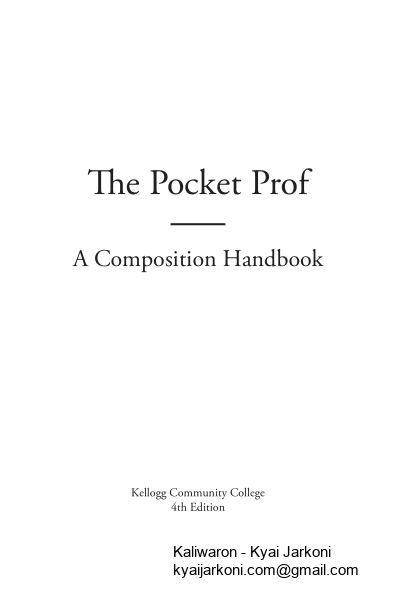The Pocket Prof. A Composition Handbook. Student: Why do we even need to know all of this writing stuff? This isn’t an English class.
72 pages
16 KB – 72 Pages
PAGE – 4 ============
POCKET PROF TABLE OF CONTENTS Introduction Etiquette Issues Netiquette 101 2Emailing Your ProfessorŠTen Tips 3Participating in Online Discussions 4Writing Organizing a Basic EssayŠOne Model 6Writing a ˜esis Statement 7Using Transitions 8Creating a Good Title 9Participating in Peer Review 10Evaluating Your Writing 11Grammar and Punctuation Common Errors: Fragments and Run-Ons 12CommaŠSix Main Uses 14Semi-Colon 16Colon 17Joining Sentences 18Apostrophe 19Homonyms 20Italics/Quotation Marks 22Capitalization 23
PAGE – 5 ============
Research and Documentation Primary, Secondary, and Tertiary Sources 24Evaluating Websites for Quality 26Types of Sources 27Integrating Source Material/Signal Phrases 28Avoiding Plagiarism 29Ellipses and Brackets 32Citing Sources 34Quick Reference Chart: APA vs. MLA 35APA Documentation 36APA: Additional Situations and Rules 37APA: Sample Student Essay 38MLA Documentation 42MLA: Additional Situations and Rules 43MLA: Sample Student Essay 44MLA: Core Elements 49Chicago Manual of Style Documentation 50Chicago: Additional Situations and Rules 51Chicago: Sample Pages 52Writing for Employment ˜e Found ation of a Résumé 56˜e Cover Letter 60˜e Interview Œ Tips for Success 62Credits and Acknowledgements
PAGE – 8 ============
2ETIQUETTE ISSUESNetiquette 101It™s never been easier to connect with professors and classmates online, but along with ease and convenience comes a certain level of responsibility when you are posting or mailing information. Keep in mind this basic rule: don™t do anything online that you wouldn™t like someone else to do to you (i.e. sending an aggressive email, posting an overly critical reply, forwarding messages to third parties without permission). Remember, your online activity leaves a permanent digital trail. Here are some finetiquettefl tips to remember in an academic setting: Act Within the Law: Ł Never send a message that threatens, harasses, or blatantly o˚ends any member of the KCC community. Ł Always give credit for words or ideas that belong to someone else. Ł Identify yourself by name. Don™t pretend to be someone else. Be Courteous and Respectful:Ł Avoid using profanity in an email or discussion forum. Ł Keep personal matters between you and your classmates and/or professors privateŠboth in online and face-to-face courses. Ł Before you press fisendfl or post something in an online discussion forum, re-read your text to make sure it won™t be misunderstood. Your readers will not necessarily know your mood or be able to read your body language. Ł If you decide to send a message via cellphone, take the time to punctuate your text properly. Ł Don™t write in all lowercase letters. Ł YOU™RE SHOUTING when you write in all capital letters! Ł Abbreviations and emoticons can help convey tone or mood, but keep in mind that they wear thin on some readers. LOL
PAGE – 9 ============
3Emailing Your ProfessorŠTen Tips 1. Put your class/section in the subject line, followed by the nature of the communication. (ENGL 151:04 Illness) 2. Use an appropriate standard greeting, such as fiDear Professor Shawfl or fiGood Morning.fl Never fiHey.fl 3. Keep the message on point. fiMy question about today™s assignment is this:fl 4. Write in standard EnglishŠno fitextspeakfl or slang. 5. Always sign your name at the end (full name if you are unknown to the recipient or ˝rst name if you are known). 6. Never ask your professor if you missed anything important; of course you have. 7. Don™t share too much personal detail if you miss class. An absence is an absence.8. If you will be missing class, always ask what you need to do to keep current. 9. Never forward jokes, memes, or chain letters to your professor. 10. Make readers want to respond. Your email is a re˙ection of you, your work habits, and your professionalism.
PAGE – 10 ============
4Participating in Online DiscussionsMany college courses provide students with opportunities to exchange ideas with their peers and professors in online forums. If you are required to participate in online discussions, make sure your posts are civil, thoughtful, and well-edited. ˜e student exchange on the next page comes from an online sociology course. ˜e students were asked to de˝ne sociological concepts. In addition, students were required to refer to the textbook to support their points. You™ll notice the students included references for their textbook. Usually references have a hanging indent. Because this was posted in a Moodle discussion board, however, hanging indents were not required. Otherwise, APA citations are correct. Exercise/Discussion:1. Where do these students use speci˝c examples to support their ideas? 2. Is there evidence that these students have learned anything from this reading assignment?3. How do these writers exhibit civility or promote further discussion? 4. In what ways do these students personalize the course material? 5. How is this discussion di˚erent from forums in which you™ve participated?
PAGE – 11 ============
5Sociology Concepts By Jennifer L.ŠWednesday, 15 February 2017, 1:26 PM I chose to explain social construction, microsociology, and the sociological imagination for important to understanding sociology. Social construction is fian idea or practice that a group of people agree exists. It is maintained Sociology points out that many behaviors thought of as biological, are actually a result of According to Introduction to Sociology, microsociology focuses on everyday behavior during small group or individual interactions, whereas macrosociology analyzes patterns in large- a microsociologist would analyze different settings, e.g. a food court, differently. Introduction to Sociology The Sociological Imagination Reference Introduction to sociology Re: Sociology Concepts By Steven R. Œ Thursday, 16 February 2017, 4:15 PM about the sociological imagination. I had not thought about this whole idea before these types of troubles as simply personal, and instead start to understand them as larger, public issues, perhaps resulting from policies, and applying to many people in Reference Introduction to sociology
16 KB – 72 Pages
